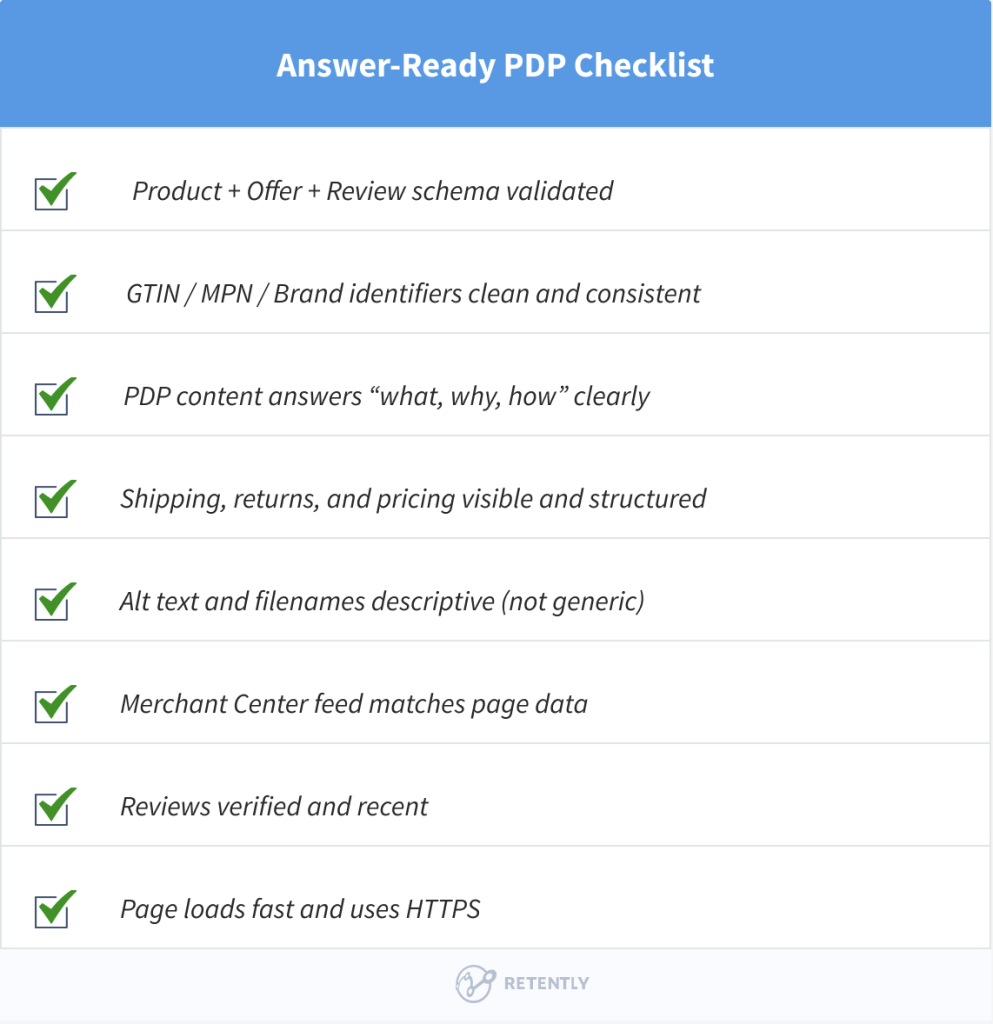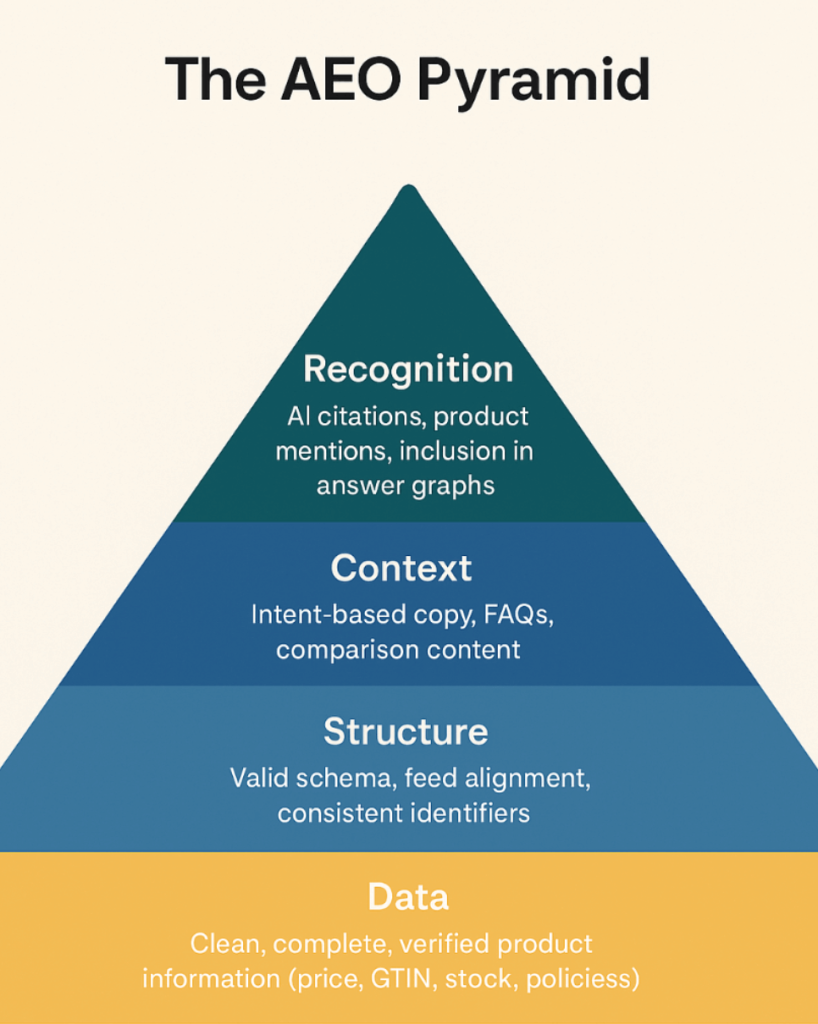Table of Contents
- Key Takeaways
- What Exactly Is Answer Engine Optimization (AEO)?
- Why Ecommerce Needs to Care Now
- How AI Engines Build Shopping Answers
- Anatomy of an Answer-Ready PDP
- Visual AEO: Teaching AI to See Your Products
- The AEO Maturity Ladder: Where Your Store Stands
- From SEO Checklist to AEO Playbook (Action Plan)
- Beyond Google: The Multiplatform AEO Landscape
- Measuring What Matters (AEO Success Metrics)
- The Next 12 Months of AEO
- The New Visibility Loop
In AI-driven search, your PDP isn’t competing for a rank, it’s auditioning for a quote.
Search used to be simple. You typed a question, hit enter, and got a list of blue links to sort through. Whoever ranked highest got the click – it was a predictable game of keywords, backlinks, and patience.
But that game is changing fast. Today, search engines don’t simply show results, they summarize them. Thanks to AI-powered tools, shoppers now see a ready-made overview before they even think about clicking. It’s clean, convenient, and usually answers their question right on the spot.
In fact, AI-generated overviews now appear in around 15% of Google searches overall, and while ecommerce coverage is still small, it’s growing rapidly. That means the traditional “rank higher, get more clicks” SEO playbook no longer guarantees visibility. Search has turned into an interpretation layer, one where AI decides what information matters, which facts are trustworthy, and whose product earns a mention.
Key Takeaways
- AI overviews are reshaping visibility. Product pages aren’t ranked, they’re referenced. Your data decides whether you’re included in the conversation.
- Structured accuracy wins trust. Clear schema, consistent feeds, and transparent policies make your store easier for AI systems to verify and cite.
- Answer-first content outperforms fluff. Pages that directly address real shopper questions are far more likely to surface in AI summaries.
- AEO extends beyond Google. Platforms like Amazon, TikTok Shop, and AI assistants all rely on structured, reliable data to power their recommendations.
- Clarity is the new currency. The brands that communicate facts precisely and consistently will become the sources AI overviews quote automatically.
What Exactly Is Answer Engine Optimization (AEO)?
So, what’s all this talk about Answer Engine Optimization? In simple terms, AEO is about making your product data and content easy for AI systems to understand, trust, and quote.
When you think about how search used to work, SEO was all about getting humans to click. You optimized titles, sprinkled in keywords, and hoped to land that top spot. But now, AI systems like Google’s Search Generative Experience (SGE), Bing Copilot, and ChatGPT Browse aren’t scrolling or clicking, they’re reading, interpreting, and deciding what’s worth including in an answer.
That’s where AEO comes to the table. SEO makes your content visible to people, while AEO makes your content visible to the machines that speak for people. The difference sounds subtle, but it’s massive. AI systems don’t “rank” pages, they assemble facts. They cross-check data, resolve product identities (like GTINs or model numbers), and select which sources sound most trustworthy.
Therefore, the goal isn’t to outsmart an algorithm anymore, but to make your product information unmistakably reliable.
Why Ecommerce Needs to Care Now
Here’s the thing: AI doesn’t care about how much you’ve spent on ads or how many backlinks you’ve earned. It cares about clarity.
AI overviews and shopping snapshots rely on structured, verified product data not brand size, not keyword tricks, not marketing spend. The systems behind Google’s SGE, Bing Copilot, and ChatGPT pull from what they can trust. And in this new trust model, AI engines cite the clearest data, not the biggest brand.
Your Google Merchant Center feed, schema markup, and verified reviews are now your biggest discoverability levers. These are the data signals that power not only Google’s overviews, but also the product knowledge graphs, marketplaces, and chat-based shopping experiences emerging everywhere.
The risk? If your PDPs are thin, inconsistent, or missing structured data, you may quietly vanish from AI summaries even if you still rank well in traditional search results.
Imagine two stores selling the same backpack:
- Store A has complete schema markup, consistent GTIN and brand identifiers, and clear shipping and return policies.
- Store B has a great design and keywords, but incomplete data and no structured markup.
When AI builds its shopping overview, Store A gets quoted, its product becomes part of the answer. Store B doesn’t even make the cut.
Therefore, today, ecommerce visibility means speaking the language AI understands fluently: clean, consistent, verifiable data.
How AI Engines Build Shopping Answers
Let’s break down what really happens when someone types, “best 40L carry-on backpack under $100”.
Answer engines are lightning-fast research assistants. Instead of scanning thousands of pages like a human would, they go through a few key steps, all in milliseconds, to figure out what to show and who to trust.
First, AI doesn’t just read what someone types, it rephrases it into something it can measure. “Best 40L carry-on backpack under $100” becomes “List 40L carry-on backpacks; compare weight, material, and price; filter by affordability.” It turns natural language into data-driven instructions.
Next, it matches those words to real products. It identifies which backpacks actually exist, connecting brand names, model numbers, and GTINs so it doesn’t confuse last year’s version with this year’s. This is where your product identifiers, structured data, and naming consistency make or break visibility.
Then, the engine starts pulling verified facts (pricing, materials, delivery times, and reviews) from trusted PDPs, merchant feeds, and structured data sources. If your page presents this clearly (with Product, Offer, and ReturnPolicy schema, for example), it’s far more likely to get cited. If your feed and your page disagree on price or stock, you lose credibility points.
Before anything is shown, the AI runs checks to filter out spammy, duplicate, or low-quality pages. It avoids unclear content, “AI-written” filler text, or anything that might look misleading or policy-violating. Thin or contradictory PDPs often get dropped here.
Finally, the AI builds the summary shoppers see – a compact, visual “answer” that includes a few cited sources or merchant tiles. This is the moment that matters: being referenced inside that overview.
When several products fit the same criteria, the AI favors completeness, clarity, and consistency. That means stable identifiers, validated schema, fast-loading pages, and transparent policies can nudge you into that final shortlist.
That’s why having an “answer-ready” PDP matters so much. Looking pretty or keyword density does not matter anymore, creating pages that machines can trust, verify, and quote confidently does.
Anatomy of an Answer-Ready PDP
If AI overviews are the new storefront, your Product Detail Page (PDP) is the display window. It tells both humans and machines, “This product is real, verified, and worth recommending.”
Here’s what separates an answer-ready PDP from an ordinary one:
Structured data that’s airtight: Think of schema as your PDP’s translator. It helps AI understand exactly what’s on the page. Make sure your Product, Offer, Review, and ReturnPolicy schemas are complete and validated. This tells AI what the item is, what it costs, who’s selling it, and what customers think of it – no guessing required.
Stable identifiers: Every product needs a digital fingerprint. Cleanly declare your GTIN (Global Trade Item Number), MPN (Manufacturer Part Number), and brand name so AI knows it’s looking at your product and not a duplicate. These identifiers are what connect your PDP to knowledge graphs, product feeds, and other verified listings across the web.
Answer-shaped copy: Write facts like you’re answering questions, not decorating a brochure. Instead of “premium, high-quality material,” say “made from recycled 600D polyester that resists tearing and water damage.” That’s data AI can understand, compare, and quote.
Clear ownership: Use brand and merchant schema to show who’s behind the page. AI engines prefer content that clearly shows authorship or brand accountability. It’s part of how they filter trustworthy sources from generic sellers.
Data harmony: Make sure your PDP data matches what’s in your Merchant Center feed, OpenGraph tags, and sitemap. A mismatch in price, stock status, or shipping info can immediately downgrade your trust score in AI systems.
Trust & compliance: Visible reviews, secure checkout (HTTPS), and clearly written return and shipping policies all count. They’re not just good UX, but AI signals that confirm your store’s legitimacy. Verified customer reviews marked up with Review and AggregateRating schema add another layer of proof, helping AI cross-validate product authenticity and customer satisfaction. Even user-generated content with measurable details (“fits true to size,” “weighs 1.2 kg”) provides the kind of structured, verifiable data that makes your products easier for AI to quote reliably.
Data freshness and update cadence: Out-of-date pricing, discontinued SKUs, or old reviews reduce your “trust freshness.” Regular feed updates and schema refreshes (daily or real-time, where possible) increase the probability of inclusion in AI answers. This is important for ecommerce credibility and aligns with Google’s SGE update cycles.
Transparency: Even your images play a role. Use descriptive filenames and alt text. “black-40L-travel-backpack.jpg” gives AI a lot more context than “image123.jpg.” Visual data verification helps confirm the product identity. For example, instead of vague copy like “Perfect travel companion”, say: “This 40L backpack fits standard airline overhead bins (22x14x9 in) and includes a laptop sleeve for 15” devices.” That’s a fact, one that the AI can verify across other sources and quote with confidence. But we’ll dwell more on the topic in a bit.
When your PDP is structured this way, you’re training AI systems to recognize, trust, and feature your products automatically.

If you can check off 80% of these boxes, congrats, your PDP is already “AI-fluent.”
Visual AEO: Teaching AI to See Your Products
Visual AEO requires special attention since answer engines don’t simply read your PDPs, they look at them. Google’s SGE, Bing Copilot, Perplexity, and ChatGPT’s browsing layer now analyze product images and even their metadata to validate what’s written in your schema. This visual cross-checking is quietly reshaping how AI trusts your content.
It’s like teaching AI to see your products the way customers do. When your PDP includes high-quality, context-rich imagery with descriptive filenames, accurate alt text, and EXIF data aligned with your structured fields. The AI can verify claims instead of just quoting them. If your text says “vegan leather tote bag” but your image metadata or pixel detection indicates genuine leather, you’ve lost credibility in the machine’s eyes.
Visual AEO also affects ranking in shopping overviews and visual searches. Google’s image understanding models (like MUM and Multisearch) now parse product details directly from images: material texture, color, dimensions, even packaging style. Clean, consistent, well-labeled visuals increase your odds of being referenced or visually displayed in AI-driven results.
In practice, Visual AEO means optimizing not just what you say, but what you show. So you need to:
- Use structured image metadata that matches your PDP schema.
- Keep consistent product imagery across your feeds, marketplaces, and site.
- Add contextual alt text that reinforces your product attributes and categories.
- Avoid generic stock-style visuals. AI models reward authenticity and detail.
Just like structured data turned PDPs into readable entities, visual alignment turns them into verifiable ones. It’s how AI learns to trust what it sees. And that’s exactly where the next layer of maturity begins – moving from readable to fully verifiable, as you’ll see in the AEO Maturity Ladder.
The AEO Maturity Ladder: Where Your Store Stands
Not every store is ready to be quoted by AI, and that’s okay. Like SEO back in its early days, AEO is a journey, not a switch you flip overnight.
To help you see where you stand, think of AEO in three levels of maturity:
Level 1: Descriptive
You’ve covered the basics. Your PDPs use standard product schema, your Merchant Center feed is connected and clean, and you’ve got at least a few authentic customer reviews. At this stage, AI engines can read your data, but they don’t fully understand it yet. You’re discoverable, but not distinguishable.
Typical signs:
- Schema markup is implemented but not validated.
- PDPs focus on SEO keywords, not structured facts.
- Data alignment between page and feed is “mostly right.”
- Reviews exist, but are not verified or detailed.
Level 2: Contextual
Now you’re thinking beyond technical compliance. Your PDPs are written with intent in mind, they answer real questions shoppers ask. You’ve aligned your structured data, feeds, and on-page content so everything tells the same story. You might also include FAQs or comparison tables that help AI assemble context.
Typical signs:
- The schema is fully validated and regularly checked.
- PDP copy includes measurable, verifiable facts.
- FAQs marked up with FAQPage schema.
- Merchant Center and PDPs are fully synchronized.
- AI overviews occasionally reference your site.
At this level, you’re building machine trust, your data is not only visible but credible.
Level 3: Referenced
This is where it clicks. Your PDPs are no longer just readable; they’re reliable enough to be reused. AI overviews start citing your products directly. You might appear in “Shop the Look,” “Compare,” or “Top Picks” experiences, often without realizing it at first.
Typical signs:
- PDPs are consistently cited or linked in AI summaries.
- Your product data is integrated into merchant knowledge graphs.
- Brand markup and identifiers (GTIN, MPN, brand schema) are complete and validated.
- You actively monitor AI mentions and feed performance.
Each level builds on the last. The more structured and consistent your data becomes, the more machines trust it and the more often your products get cited, referenced, and featured in AI-driven shopping experiences.

From SEO Checklist to AEO Playbook (Action Plan)
Let’s turn all this theory into a plan you can actually run. Think of AEO as your next-generation visibility system, not another checklist, but a smarter way to make sure your products earn their place in AI-generated answers.
Here’s a step-by-step game plan to get you there:
Step 1: Audit your schema and fix feed inconsistencies: Start by running a complete check of your PDP schema and Merchant Center feed. Ensure that your Product, Offer, Review, and Return Policy markup is valid and that prices, availability, and GTINs are consistent across all data sources. Even small mismatches (like “in stock” on your feed but “out of stock” on your page) can knock you out of AI summaries.
Step 2: Map your “answer entities”: AI engines think in entities, not adjectives. For your top 50 SKUs, document the core facts that define each product, materials, dimensions, compatibility, use case, warranty, and care details. This “entity map” becomes your source of truth for every PDP rewrite, feed update, and schema entry.
Step 3: Rewrite PDPs for factual clarity and verification: Rewrite your PDPs so they answer shopper questions instead of describing products in vague terms. Replace: “High-quality lightweight bag”, with: “Weighs 1.2 kg and made from recycled 600D nylon.” The goal? Make your facts verifiable by AI and comparable against competitors.
Step 4: Bridge AEO to brand storytelling (not just data): Structured data earns you visibility, but brand storytelling earns you memorability. Pair factual clarity with unique positioning – your sustainability story, your origin, your materials – so when AI cites your facts, it also reinforces your brand.
Step 5: Add structured FAQs and comparison content: FAQs and product comparisons are AEO gold. Add them directly to PDPs and mark them up with the FAQPage schema. For example: “Will it fit a 15-inch laptop?” or “How does it compare to the 2023 model?”. The clearer your comparisons, the more context AI has to quote.
Step 6: Track inclusion in AI summaries: Visibility doesn’t stop at clicks. Use tools like Google Search Console, Bing Insights, and emerging platforms like SGE Watchers to see if your products or brand are mentioned in AI overviews. Mentions without clicks often signal early AEO success – your data is being read and referenced.
Step 7: Iterate based on missing citations: Treat AI visibility like an evolving content index. When your PDPs aren’t being cited, dig into why. Inconsistent identifiers, missing attributes, or weak markup are often to blame. Then fix, test, and repeat. Every update you make strengthens your store’s credibility in the machine layer of the web.
Beyond Google: The Multiplatform AEO Landscape
AEO isn’t a “Google thing” anymore, it’s becoming the shared language of product visibility. Every major platform is quietly building its own answer engine, powered by structured product data, verified feeds, and transparent merchant information.
Let’s take a quick tour of where AEO signals are showing up right now:
Amazon has been training its own answer engine for years. Its product comparison cards, Q&A summaries, and “Amazon’s Choice” badges already depend on structured data and verified listings. The richer your attributes, reviews, and identifiers, the more likely your products appear in Amazon’s auto-generated recommendation blocks.
TikTok’s shopping algorithm doesn’t just push viral videos, it’s learning to recognize and recommend verified products. Its internal “Product Catalog” uses similar metadata to Google Merchant Center: price, inventory, category, and product identifiers. Clean, consistent product data means your items are easier to surface in AI-driven shopping feeds and “Shop this video” overlays.
AI chat systems are quickly becoming discovery engines in their own right. ChatGPT’s browsing mode and Perplexity’s shopping summaries cite PDPs with clear schema, stable URLs, and transparent data. If your site’s product pages are structured and verifiable, these models can pull your listings directly into conversational answers even if your brand isn’t mentioned by name.
Meta is merging shopping, messaging, and AI assistance. Its new AI search layers (rolling out through Shops and Messenger) rely on structured metadata and catalog integrations. Unified feeds, the same ones you send to Google or TikTok, now inform how products are discovered across Meta’s ecosystem.
When your Google Merchant feed, TikTok catalog, and PDP schema all speak the same “language,” AI systems across multiple ecosystems can identify, verify, and recommend your products consistently.
And as these platforms evolve, AI isn’t simply connecting products to searches, but starting to connect them directly to purchases.
Agentic Commerce: When Answers Turn Into Actions
The same way search evolved into answers, answers are now evolving into actions. This shift is what many call agentic commerce: AI systems that don’t just recommend products but actively help users find, compare, and buy them, all within the chat itself.
If a shopper today asks ChatGPT, “What’s the best noise-cancelling headphone under $300?”, the AI no longer lists websites to visit. It interprets intent, pulls structured product data, validates details, and presents an organized shortlist, sometimes even linking to direct checkout flows through ChatGPT apps or embedded merchant integrations. Google is testing similar capabilities in its Search Generative Experience, while Perplexity and Amazon’s upcoming “AI shopping assistant” are building interfaces where the entire journey (discovery, evaluation, and purchase) happens inside a single conversation.
Consumers are warming up to the idea of letting AI shop for them. A recent U.S. survey showed that 34% of people would allow an AI assistant to make purchases on their behalf. That trust is already translating into revenue: during the 2024 holiday season, AI-influenced online sales reached $229 billion, up from $199 billion the previous year.
For ecommerce brands, this is both an opportunity and a filter. AI agents choose which products to show, not by who bids the most, but by who provides the most accurate and verifiable data. That’s where 1P vs 3P validation becomes decisive. AI systems cross-check your first-party data – your official product feeds, PDPs, and Merchant Center listings – with third-party data such as marketplace records, manufacturer catalogs, and review aggregators. When the information aligns perfectly, your product is treated as trustworthy. When there’s a mismatch in price, dimensions, or stock availability, the AI simply excludes it.
In this new context, a PDP is not a marketing asset, it’s an API of trust. Every structured field becomes part of the logic that determines whether your product appears in AI-driven shopping results. AEO is gradually expanding from making your content readable to making your data actionable – not just referenced but executed.
This is where ecommerce visibility is heading: not toward more clicks, but toward frictionless AI-mediated decisions. The brands that invest in transparent data, consistent feeds, and schema depth will be the ones that show up when someone’s next purchase starts and ends inside a chat.
Measuring What Matters (AEO Success Metrics)
AEO changes what visibility looks like and how you measure it. Your brand might not always get the click, but if your products are being referenced, you’re already winning.
Here’s how to track what actually matters:
1. Citations & Mentions in AI Answers
One of the biggest signs your AEO work is paying off is when your brand or product starts showing up in AI-generated summaries. These are often “zero-click” mentions. Shoppers see your brand name or data quoted inside the overview, even if they don’t click through. That’s early proof that your structured data is being trusted and reused. Tools like Search Console, Bing Insights, or AI visibility trackers (like SGE Watchers) can help you spot these mentions.
2. Schema Validation Rate & Feed Alignment
Check your structured data regularly. Are all your key PDPs fully validated? Are your Merchant Center feeds in perfect sync with your on-page data? Even a small mismatch between page and feed (like a price or stock discrepancy) can disqualify you from AI summaries. A healthy AEO setup keeps those two perfectly aligned 100% of the time.
3. Brand Inclusion in Knowledge Graphs or Shopping Carousels
As AI engines build their “answer graphs,” they connect verified entities (brands, products, and categories) into a network of trust. When your store appears in a knowledge graph, shopping carousel, or AI comparison block, it means your data is recognized and linked across systems. That’s authority.
4. Customer Trust KPIs
The traffic you do get from AI overviews tends to be highly qualified. You’ll notice lower bounce rates, stronger intent (visitors go straight to checkout or comparison), and higher engagement per session. That’s because AI has already pre-qualified those users by showing them exactly what they were looking for.
5. Business-Level ROI
This is where AEO delivers real payoff. When your product data earns visibility in zero-click results, you effectively lower your customer acquisition cost (CAC) while increasing discoverability. You’re not buying clicks but earning trust at scale.
The Next 12 Months of AEO
Over the next year, the landscape around Answer Engine Optimization will shift faster than at any point since the rise of SEO itself. AI Overviews, merchant data integrations, and conversational shopping are no longer experiments, they’re becoming the default way people discover and evaluate products.
Ecommerce isn’t waiting for AI, it’s already reorganizing around it. A 2024 Digital Commerce 360 survey found that 70% of ecommerce organizations see AI as “very or extremely important” to their operations, and 84% of brands list AI as a top strategic priority. The global AI-in-ecommerce market already exceeds $9.01 billion and is projected to triple by 2032.
As Google expands SGE’s product data partnerships, shopping-intent queries are projected to reach 30-40% coverage within the next 12-18 months. That growth will put new weight on verified Merchant Center feeds and structured PDP data.
Early SGE tests already prioritize merchants whose feeds include complete product identifiers, transparent return policies, and stable pricing. For ecommerce teams, the takeaway is clear: data reliability is the new visibility.
Meanwhile, new answer engines are multiplying fast. Platforms such as Perplexity, You.com, Brave Search, and Arc Search are developing their own answer-style layers that surface summarized product information directly in results. Each of these engines relies on similar principles – schema consistency, factual completeness, and first-party verification – giving rise to a truly multi-platform AEO strategy.
Finally, the rise of conversational commerce will extend these principles beyond the browser. Voice and chat assistants (ChatGPT Browse, Siri, Alexa, and Google’s own AI helpers, etc.) will draw from the same structured clarity to recommend and validate purchases. In this environment, your product data isn’t just for Google anymore; it’s for every AI that can read, quote, or transact on your behalf.
The next 12 months will define what “visibility” means in AI-driven commerce. Brands that align their data early (clean schema, verified feeds, and consistent visuals) won’t just rank higher. They’ll be trusted first, referenced next, and ultimately transacted through.
The New Visibility Loop
In the past, visibility came from ranking: the higher your listing, the more clicks you earned. But now, visibility is earned through trust. AI systems surface brands they can verify, not just those that optimize well. Every time you publish a verified fact, you’re giving AI another reason to treat your data as credible.
In this new loop, facts create trust, and trust creates visibility. AI doesn’t simply index what you say, it builds a profile of your brand based on how consistent, clear, and transparent your data is across every channel. That consistency is what gets you cited, mentioned, or featured when shoppers ask their next question.
Clarity is the new currency of ecommerce. Every product spec, image alt tag, and transparent policy helps AI understand you and when it understands you, it recommends you.
If you feed the facts, the answers will follow.


































 Christina Sol
Christina Sol 




 Greg Raileanu
Greg Raileanu 